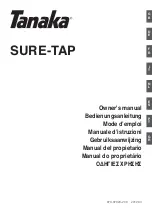
EN
9
WWW.VONROC.COM
10. Put the bevel table (3) back in place. Ensure the
notches on the left side of the bevel table (3)
align with the holes in the housing. Then press
the table downwards, fixating the table.
Assembly of the riving knife (Fig.D)
1. Unscrew the two (crosshead) screws and place
the foot of the riving knife (8) on the table.
2. Mount the riving knife (8) by tightening the two
screws.
Installing the guard (Fig.E)
1. Connect the guard to the riving knife (8) with
the knob (9) and the locknut.
2. Tighten the knob (9).
Replacing the cutting wheel (Fig. A, B & C)
1. Pull the bevel table handle (5) and remove the
bevel table (3).
2. Loosen the safety guard’s knob (9) and remove
the safety guard (10).
3. Loosen the screw holding the lower blade guard
(19), as shown on figure C.
4. Remove the lower blade guard (19).
5. Put the hex wrench(15) on the wheel nut (17)
and the spindle wrench (16) on the spindle
(18). Loosen the nut with the wrenches, as
shown on figure B.
6. Remove the nut (17) and the outside flange
(21) from the spindle (18).
7. Replace the cutting wheel (7).
8. Mount the outside flange (21) and afterwards
add the wheel nut (17).
9. Tighten the nut by using the wrenches.
10. Now re-mount the lower blade guard (19) and
fixate it by tightening the screw.
11. Put the bevel table (3) back in place. Ensure the
notches on the left side of the bevel table (3)
align with the holes in the housing. Then press
the table downwards, fixating the table.
12. Add the safety guard (10) on the riving knife (8)
and tighten the knob (9).
Installing the parallel guide (Fig. F & G)
1. Turn knob (14) on parallel guide (13) counter-
clockwise to loosen.
2. Attach the parallel guide (13) from the side of
the table as shown on figure F.
3. Turn parallel guide knob (14) clockwise to tigh-
ten securely.
Installing the miter guide (Fig.G)
1. Slide miter guide (12) onto parallel guide (13).
2. Adjust parallel guide to (13) desired position
and secure.
3. Adjust to desired angle using angle scale and
tighten securely with miter guide knob (11).
Installing the overflow drain (Fig. A & H)
1. Pull the bevel table handle (5) and remove the
bevel table (3).
2. Push overflow drain (22) into hole firmly.
3. Put the bevel table (3) back in place. Ensure the
notches on the left side of the bevel table (3)
align with the holes in the housing. Then press
the table downwards, fixating the table.
Filling the water reservoir (Fig. A & I)
1. Pull the bevel table handle (5) and remove the
bevel table (3).
2. Fill water reservoir (24) with clean tap until the
maximum fill line, as indicated on the overflow
drain (22).
3. Put the bevel table (3) back in place. Ensure the
notches on the left side of the bevel table (3)
align with the holes in the housing. Then press
the table downwards, fixating the table.
Be aware that the overflow drain prevents
overfilling. Water will overflow when you fill
water above the fill line.
Change reservoir water (Fig. A & I)
1. Pull the bevel table handle (5) and remove the
bevel table (3).
2. Put the tile saw on a bucket.
3. Remove overflow drain (22).
4. Empty the reservoir (24) into the bucket.
5. Re-mount the overflow drain (22).
6. Put the tile saw on a stable surface, for example
on the ground.
7. Fill water reservoir (24) with clean tap water
until the maximum fill line, as indicated on the
overflow drain (22).
8. Put the bevel table (3) back in place. Ensure the
notches on the left side of the bevel table (3)
align with the holes in the housing. Then press
the table downwards, fixating the table.










































